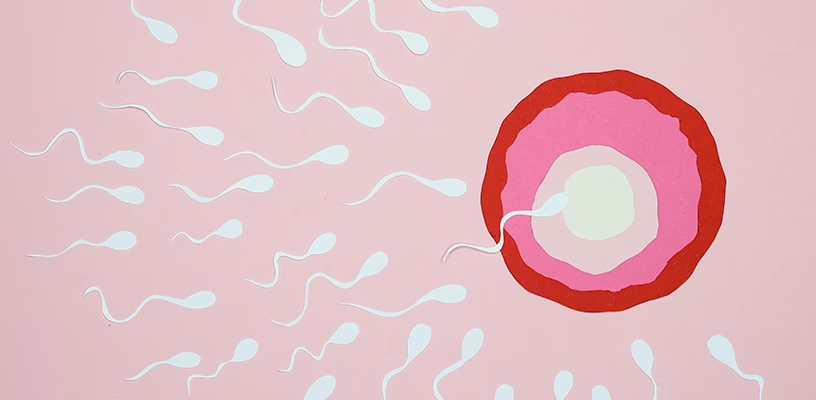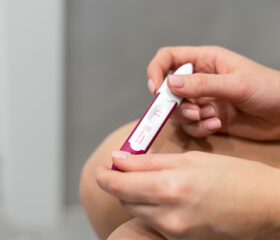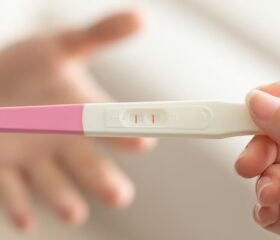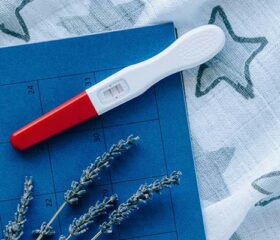Can You Get Pregnant from Precum (And What Are the Chances of It Happening)?
Whether you’re trying your best to get pregnant or doing everything you can to avoid it, you may have heard that you can get pregnant from precum.

- What is precum?
- Can you get pregnant from precum?
- Factors that affect your pregnancy risk from precum
- Is the withdrawal method reliable as a form of birth control?
- What are more reliable contraceptive methods you can use?
- How the withdrawal method compares to other birth control methods
- What is an emergency contraception?
- When should you take a pregnancy test?
- Final thoughts
Precum—also known as pre-ejaculate—is distinct from semen. In this article, we’ll examine what precum is and answer the question of whether you can get pregnant from it or not.
What is precum?
Precum is a clear fluid that’s released from the penis when a man is aroused. Men produce precum before ejaculation and don’t have any control over it. 1 The amount of precum a man releases varies from just a few drops to a teaspoon.
The fluid is secreted by the bulbourethral glands or Cowper’s glands, which are located near the urethra, a tube in the penis that lets semen and urine leave a man’s body.
Pre-ejaculate serves as a lubricant during sex and neutralizes any acidity in the urethra, making it a more hospitable environment for sperm. 2
Can you get pregnant from precum?
While precum isn’t “supposed” to contain any sperm, it’s still possible to get pregnant from precum.
The reason is that a man’s precum may pick up sperm cells left over in the urethra from previous ejaculations. 3 This typically happens if a man becomes aroused again shortly after an ejaculation.
It only takes one sperm cell to fertilize an egg. This means that regardless of how little sperm is present in pre-ejaculate, it has the potential to cause pregnancy.
That said, the odds of getting pregnant from this “carry-over” of sperm into precum are significantly lower than with a full ejaculation. 4
Factors that affect your pregnancy risk from precum
In addition to the amount of sperm in precum, several other factors can influence the overall risk of pregnancy from it. Here they are:
- Timing of ovulation: A woman is most fertile around 5 days before ovulation and the day of and after ovulation. 5 If you have sex during this time and sperm is present in the precum, you have a higher chance of getting pregnant, so make sure you’re keeping track of your fertile window by using ovulation test strips or an ovulation calculator.
- Menstrual cycle: You’re less likely to get pregnant during your menstrual period. However, if you have a shorter cycle and ovulate early, it’s still possible to get pregnant on your period.
- Sperm health and mobility: Sperm that’s strong and healthy is more likely to fertilize an egg, while sperm that are poorly formed or less mobile have a lower chance of succeeding.
- Use of other contraception: If you’re consistently and correctly using reliable forms of contraception, such as condoms, birth control pills, or IUDs, your risk of pregnancy from precum is much lower.
Note that sperm can survive in the reproductive tract for up to 5 days. 6 Even if you have sex a few days before your fertile window, you can still get pregnant.
Is the withdrawal method reliable as a form of birth control?
Also referred to as the pull-out method, the withdrawal method is when your partner removes his penis from your vagina before he ejaculates. The idea is that as long as your partner doesn’t ejaculate in you, his sperm can’t reach your egg and fertilize it.
However, the withdrawal method isn’t a particularly reliable form of birth control. You’re more likely to get pregnant with this than with other birth control methods.
Why pulling out isn’t a very effective birth control method
There are two problems with the pull-out method.
One is that the secretion of precum is involuntary. A man can’t control when or how much precum he releases, and men often don’t even realize they’ve released precum. Even though getting pregnant from the relatively small amounts of sperm present in precum is less likely, it’s still possible.
The other (bigger) problem is that the withdrawal method is difficult to consistently execute correctly. In the heat of the moment, it can be tricky to pull out before ejaculation, and even if a man manages it 99 times out of 100, even just one accident can result in pregnancy.
Your odds of pregnancy with the withdrawal method
When executed correctly, the withdrawal method is about 96% effective. 7 On paper, that isn’t a terrible failure rate; for comparison, condoms are 98% effective. However, that figure is misleading, because again, relatively few couples manage to pull it off perfectly every time.
In the real world, the withdrawal method is just 78% effective, meaning that over 1 in 5 couples who exclusively rely on it will experience an unwanted pregnancy in a given year.
You can also get STDs from precum
In addition to containing trace amounts of sperm, precum can also contain some of the microbes that cause sexually transmitted diseases (STDs). If you want to practice safe sex (particularly casual sex), the withdrawal method just isn’t enough.
What are more reliable contraceptive methods you can use?
When it comes to preventing unwanted pregnancy, the ideal is to stick with reliable contraception methods and use them consistently. Here are other methods you can consider.
Barrier methods
These are some of the most common and effective methods. The way they work is very straightforward—by preventing sperm from entering the vagina.
All but one of the barrier methods are for women. The most common ones include:
- For males: Men can wear external condoms on the penis. Again, when used correctly, these are 98% effective. 8
- For females: Options include internal condoms or a diaphragm, cervical cap, or contraceptive sponge, all of which are placed inside the vagina. Another option is to use spermicide, a gel that kills sperm cells; you apply it in your vagina near your uterus.
Condoms for both males and females can prevent HIV and other STIs. Diaphragms, cervical caps, and sponges can’t.
Hormonal methods
Hormonal birth control methods use hormones to keep your ovaries from releasing eggs or thicken your cervical mucus so that sperm can’t pass through. Options include:
- Birth control pills: Being “on the pill” means taking birth control pills daily.
- Shot: Your doctor will give you a shot every 3 months.
- Patch: These patches are put on your skin to release hormones into your bloodstream. You’ll need to replace them once a week and take a one-week break every month.
- Ring: This is a thin, flexible ring that goes in your vagina. You’ll need to replace it once a month.
These hormonal methods only prevent unwanted pregnancies, not STIs. Use condoms to protect yourself from infection.
Long-acting reversible contraception (LARC)
Long-acting reversible contraception (LARC) is very effective at preventing pregnancy. There are two types of LARCs: intrauterine devices (IUDs) and hormonal implants. Both work to prevent sperm from fertilizing eggs and are very effective.
IUDs
This is a small, T-shaped intrauterine device (IUD) that a doctor inserts into your uterus. One type contains levonorgestrol, a synthetic version of the female hormone progesterone. 9 The hormone in the IUD prevents ovulation and thickens the mucus in your cervix, making it much harder for sperm to enter the uterus and reach the egg. 10 A LARC can remain effective for up to 3–8 years. 11 The other type of IUD is copper and does not contain hormones. 12
Hormonal implant (Nexplanon)
This is a small, thin rod that a doctor inserts under your upper arm’s skin. As with the hormonal IUD, it contains etonorgestrol, which inhibits the sperm from reaching your egg. It can last up to 3 years. 11
Permanent birth control
If you’re sure you don’t want children, you can get a form of permanent birth control (sterilization). Here’s how this works for males and females:
- Vasectomy (for males): This is when a doctor blocks the tubes that carry sperm. Men can still ejaculate after a vasectomy, but they won’t release any sperm.
- Tubal ligation (for females): Similarly, with tubal ligation, the doctor blocks the tubes that carry eggs into a female’s uterus.
If you change your mind, you can get a vasectomy or tubal ligation reversal. Be aware that a vasectomy reversal has a much higher chance of succeeding than a tubal ligation reversal, which is major surgery to undergo and likely to fail.
How the withdrawal method compares to other birth control methods
Refer to the table below to see how pulling out compares to the other contraceptive methods we just mentioned:
| Contraceptive method | Efficacy | Frequency of use | Potential side effects |
|---|---|---|---|
| Condoms | 98% (if used perfectly) 87% (typical use) |
Use every time you have sex | - Potential allergic reactions (latex) |
| Internal condoms | 95% (if used perfectly) 79% (typical use) |
Use every time you have sex | - Potential allergic reactions (latex) - Irritation from friction |
| Diaphragm | 94% (if used correctly) 83% (typical use) |
Use every time you have sex | - Increased risk of urinary tract infections (UTIs) - Using spermicide with a diaphragm can cause irritation |
| Cervical cap | 86% (if you’ve never given birth) 71% (if you’ve given birth before) |
Use every time you have sex | - Can be uncomfortable or cause irritation - Using spermicide with a cervical cap can cause irritation |
| Spermicide | 79%–86% | Use every time you have sex | - May cause irritation - No protection from STDs - Irritation can increase your risk of STDs |
| Contraceptive sponge | 91% (if used perfectly) 86% (if you’ve never given birth) 78% (if you’ve given birth before) |
Use every time you have sex | - Spermicide in sponge can cause irritation - No protection from STDs - Irritation can increase your risk of STDs |
| Birth control pills | 99% (if used perfectly) 93% (typical use) |
Take one pill every day | - Headaches - Nausea - Sore breasts - Changes to your menstrual cycle - Spotting - No protection from STDs |
| Copper IUD | 99% | Once inserted, it works for up to 12 years | - Spotting between periods - Changes to your menstrual cycle (longer, more irregular, and worse cramping) - Pain when your IUD is inserted - Cramping or backaches after your IUD is inserted - No protection from STDs |
| Hormonal IUD | 99% | Once inserted, it works for 3–8 years | - Spotting between periods - More irregular periods - Pain when your IUD is inserted - Cramping or backaches after your IUD is inserted - No protection from STDs |
| Birth control patch | 99% (if used correctly) 93% (typical use) |
Replace it every week | - Spotting or bleeding between periods - Sore breasts - Nausea - Headaches - Slightly increased risk of heart attacks, stroke, blood clots, and liver tumors - No protection from STDs |
| Birth control ring | 99% (if used correctly) 93% (typical use) |
Change it once a month | - Spotting or bleeding between periods - Changes to your menstrual cycle (earlier, later, or stopping altogether) - Sore breasts - Nausea - Headaches |
| Birth control shot | 99% (if following the schedule correctly) 96% (typical use) |
Given once every 3 months | - Spotting or bleeding between periods - Changes to your menstrual cycle (more bleeding or not getting your period at all) - Nausea - Weight gain - Headaches - Sore breasts - Depression - Mild bruising from shots - In rare cases, a small permanent dent from the shot |
| Emergency contraceptive pill | 75%–89% (if taken within 3 days of unprotected having sex) | Taken within 3 days after having sex | - Changes to your menstrual cycle (heavier, earlier, later, or more spotty) - Headaches - Nausea - Dizziness or lightheadedness - Sore breasts |
| Vasectomy (for men) | 99% | One procedure—lasts for life (reversible) | - Pain in your scrotum - Bruising - Infection |
| Tubal ligation (for women) | 99% | One procedure—lasts for life | - Very difficult to reverse - Bleeding - Infection - Increases the risk of ectopic pregnancy |
| Breastfeeding | 98% (if breastfeeding exclusively) | You must be breastfeeding exclusively, at least 4 hours during the day and 6 hours at night | - Lower vaginal lubrication can make sex uncomfortable - Breastfeeding can be painful |
What is an emergency contraception?
Emergency contraception (EC) is an option for those who had unprotected sex, forgot to use birth control, or had an accident with it (e.g., the condom broke or slipped). There are two types of emergency contraception:
- Copper IUD: This long-acting reversible contraception mentioned earlier can serve as an emergency contraception if it’s put into your vagina within 120 hours of having unprotected sex. 13
- Emergency contraceptive pills (ECPs): Commonly known as the “morning after pill,” you must take these hormonal pills as soon as possible after you have unprotected sex. Different ECPs may have specific instructions on how soon you should take them (often within 3–5 days).
Act quickly if you have unprotected sex or an issue with your birth control. Generally, the sooner you use these emergency contraceptives, the better chance you have of preventing an unwanted pregnancy.
When should you take a pregnancy test?
You should take a pregnancy test any time you have reason to believe you might be pregnant (e.g., your period is late). It’s worth taking one whether or not you used contraception, regardless of what method you used; unfortunately, no methods are completely effective.
You can buy home pregnancy tests at your local supermarket or pharmacy. While you can take a test even before your period usually starts, you’ll get more accurate results after you miss your period (1–2 weeks afterward, if you can wait that long). 14
If you get a positive result from a home test, schedule a doctor’s appointment right away. Your doctor can confirm the results and discuss your options and the next steps if you’re pregnant.
Final thoughts
You’re less likely to get pregnant from precum compared to a full ejaculation, but it’s certainly not impossible. If you don’t want to get pregnant, use a reliable contraceptive.
Having an unplanned pregnancy can significantly affect your life. The good news is there are many ways for you to have control over your body and family planning these days. Take steps to protect yourself, and don’t hesitate to consult your doctor if you have any questions.
Article Sources
- ISSM. "What is pre-ejaculate or precum?" Retrieved May 2, 2025.
- SEER Training Modules. "Accessory Glands" Retrieved May 2, 2025.
- International Planned Parenthood Federation. "What is pre-ejaculatory fluid (also known as pre-cum), and can it cause pregnancy?" Retrieved May 2, 2025.
- Contraception. "Low to non-existent sperm content of pre-ejaculate in perfect-use contraceptive withdrawal, a pilot study" Retrieved May 2, 2025.
- Johns Hopkins Medicine. "Calculating Your Monthly Fertility Window" Retrieved May 2, 2025.
- MedlinePlus. "Pregnancy - identifying fertile days" Retrieved May 2, 2025.
- Planned Parenthood. "How effective is pulling out?" Retrieved May 2, 2025.
- Planned Parenthood. "How effective are condoms?" Retrieved May 2, 2025.
- StatPearls. "Progestins" Retrieved May 2, 2025.
- Cleveland Clinic. "Hormonal IUD" Retrieved May 2, 2025.
- American College of Obstetricians and Gynecologists. "Long-Acting Reversible Contraception (LARC): Intrauterine Device (IUD) and Implant" Retrieved May 2, 2025.
- Mayo Clinic. "Copper IUD (ParaGard)" Retrieved May 2, 2025.
- MedlinePlus. "Birth Control" Retrieved May 2, 2025.
- U.S. Food & Drug Administration. "Pregnancy" Retrieved May 2, 2025.







